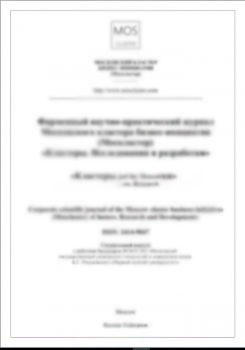, Russian Federation
The article is devoted to solving the problem of assessing additional microaccelerations arising as a result of a temperature shock when a small spacecraft leaves the Earth's shadow and dives into it, in order to develop recommendations for controlling the level of microaccelerations in the area of technological equipment intended for the implementation of gravitationally sensitive technological processes on board. small spacecraft
contact mechanics of engineering surfaces, friction and wear of interfaces, tribotechnical materials science, mechanics and control processes, kinematics, dynamics, strength and reliability of machines and structural elements
1. M. Y. Ovchinnikov, D. S. Roldugin, S. S. Tkachev and V. I. Penkov, B-dot algorithm steady-state motion performance, Acta Astronautica 146 (2018), pp. 66–72.
2. V. Sedelnikov, Fast analysis of Oonboard measurements of the Earth magnetic field for the purpose of microaccelerations decrement on board of the “AIST” small spacecraft during its uncontrolled orbital fligh, International Review of Aerospace Engineering, 11(2) (2018), pp. 76–83.
3. V. Sedelnikov, V. S. Rodina and D. I. Orlov, Modeling the effect of temperature deformations of large elements on the dynamics of the orbital motion of a small spacecraft, Journal of Physics: Conference Series 1368(4) (2019) 042074.
4. G. P. Anshakov, A. I. Belousov, A. V. Sedelnikov and Y. Y. Puzin, Effect of the mission and supporting equipment on operation of the magnetometer sensors of the Foton-M No. 2, Spacecraft Russian Aeronautics, 62(4) (2019), pp.571–576.
5. V. I. Abrashkin, K. E. Voronov and A.V. Piyakov, Uncontrolled rotary motion of the AIST small spacecraft prototype, Cosmic Research, 55(2) (2017), pp. 128 – 141.
6. G. P. Anshakov, A. I. Belousov and A. V. Sedelnikov, Efficiency estimation of electrothermal thrusters use in the control system of the technological spacecraft motion, Russian Aeronautics, 61(3) (2018), pp. 347-354.
7. M. K. Chamberlain, S. H. Kiefer and J. A. Banik, On-orbit structural dynamics performance of the roll-out solar array, American Institute of Aeronautics and Astronautics Spacecraft Structures Conference, 2018, pp. 1-9.
8. A.V. Sedelnikov, E. S. Khnyryova, A. S. Filippov and T. A. Ivashova, Measurements analysis of the Earth’s magnetic field data obtained from the flight model of AIST small spacecraft, International Journal of Mechanical Engineering and Robotics Research, 8(4) (2019), pp. 542-46.
9. Belousov, A. V. Sedelnikov and K. I. Potienko, Study of effictive application of electric jet eEngine as a mean to reduce microacceleration level, International Review of Aerospace Engineering, 8(4) (2015), pp. 157-160.
10. V. Sedelnikov and A. A. Kireeva, Alternative solution to increase the duration of microgravity calm period on board the space laboratory, Acta Astronautica 69(6-7) (2011), pp. 480-484.
11. Belousov and A. V. Sedelnikov, Probabilistic estimation of fulfilling favorable conditions to realize the gravity-sensitive processes aboard a space laboratory, Russian Aeronautics 56(3) (2013), pp. 60-63.
12. G. P. Anshakov, A. I. Belousov and A. V. Sedelnikov, The problem of estimating microaccelerations aboard Foton-M4 spacecraft, Russian Aeronautics 60(1)(2017), pp. 83-89.
13. B. Ushakov and E. A. Ilyin, Advances of space medicine and biology research in Russia 47th session of the STS of the Committee on the Peaceful Uses of Outer Space (Vienna Austria), 2010.
14. V. Sedelnikov, Classification of microaccelerations according to methods of their control Micrograv. Microgravity Science and Technology, 27(3) (2015), pp. 245-51.
15. V. Sedelnikov, Evaluation of the level of microaccelerations on-board of a small satellite caused by a collision of a space debris particle with a solar panel, Jordan Journal of Mechanical and Industrial Engineering, 11(2) (2017), pp. 121-127.





